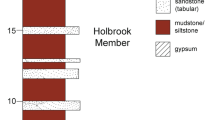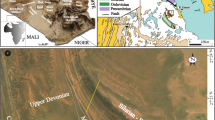Abstract
The Zhangcunping area is located at the north limb of the Huangling anticline in Yichang, Hubei Province. Here, the sedimentary succession of the Ediacaran Doushantuo Formation is similar with that in the Weng’an area, Guizhou Province. A large number of new microfossils (mainly acanthoacritarchs) from the Doushantuo Formation in this area are reported in this paper. The fossil assemblage shows similarity as the phosphatized biota of the Doushantuo Formation at Weng’an, Guizhou Province and the silicified biota of the Doushantuo Formation at the Yangtze Gorges, which suggests that the Zhangcunping area is a key for correlation of the Doushantuo Formation between the Weng’an area, Guizhou Province and the Yangtze Gorges. Besides, a new zircon SHRIMP U-Pb age (614.0±7.6 Ma) is first obtained from a horizon underneath the exposed surface in the middle of the Doushantuo Formation in the Zhangcunping area. This age not only provides a new datum for subdivision of the Ediacaran Doushantuo Formation, but also indicates that the age of the exposed surface in the middle of the Doushantuo Formation in the Yangtze Platform should be posterior to 614.0±7.6 Ma. Due to the horizon of the Weng’an biota situated above the exposed surface, the age of the Weng’an biota should be posterior to 614.0±7.6 Ma as well.
Similar content being viewed by others
References
Liu P J, Xiao S H, Yin C Y, et al. Silicified tubular microfossils from the upper Doushantuo Formation (Ediacaran) in the Yangtze Gorges area, South China. J Paleont, 2009, (in press)
Xiao S H. New multicellular Algal fossils and Acritarchs in Doushantuo chert nodules (Neoproterozoic; Yangtze Gorges, South China). J Paleont, 2004, 78(2): 393–401
Yin C Y. New discovery of Sinian Doushantuo Microfossils from Miaohe, Zigui, Hubei (in Chinese with English abstract). Acta Geos Sin, 1996, 17(3): 322–329
Yin C Y. Microfossils from the upper Sinian (Late Neoproterozoic) Doushantuo Formation in Changyang, Western Hubei, China. Cont Dyn (Inst Geol, CAGS), 1999, 4(2): 1–18
Yin L M, Zhu M Y, Knoll A H, et al. Doushantuo embryos preserved inside diapause egg cysts. Nature, 2007, 446(5): 661–663
Zhang Y, Yin L M, Xiao S H, et al. Permineralized fossils from the Terminal Proterozoic Doushantuo Formation, South China. Palaeontol Soc Mem, 1998, 50: 1–52
Tang F, Yin C Y, Liu Y Q, et al. A new discovery of macroscopic fossils from the Ediacaran Doushantuo formation in the Yangtze Gorges area. Chin Sci Bull, 2006, 51(12): 1487–1493
Chen M E, Xiao Z Z, Yuan X L. A new assemblage of megafossils— Miaohe biota from Upper Sinian Doushantuo Formation, Yangtze Gorges (in Chinese with English abstract). Acta Palaeontol Sin, 1994, 33: 391–403
Xiao S H, Yuan X L, Steiner M, et al. Macroscopic carbonaceous compressions in a terminal Proterozoic shale: a systematic reassessment of the Miaohe biota, South China. J Paleont, 2002, 76(2): 345–374
Tang F, Yin C Y, Bengtson S, et al. Octoradiate spiral organisms in the Ediacaran of south China. Acta Geol Sin, 2008, 82(1): 27–34
Condon D, Zhu M Y, Bowring S, et al. U-Pb ages from the Neoproterozoic Doushantuo Formation, China. Science, 2005, 308: 95–98
Yin C Y, Tang F, Liu Y Q, et al. U-Pb zircon age from the base of the Ediacaran Doushantuo Formation in the Yangtze Gorges, South China: constraint on the age of Marinoan glaciation. Episodes, 2005, 28(1):48–49
Yin C Y, Tang F, Liu Y Q, et al. New U-Pb zircon ages from the Ediacaran(Sinian) System in the Yangtze Gorges: constraint on the age of Miaohe biota and Marinoan glaciation. Geol Bull Chin, 2005, 24(5): 393–400
Zhang S H, Jiang G Q, Zhang J M, et al. U-Pb sensitive high-resolution ion microprobe ages from the Doushantuo Formation in south China: Constraints on late Neoproterozoic glaciations. Geology, 2005, 33(6): 473–476
Zhou C M, Xie G W, Xiao S H. New data of microfossils from Doushantuo Formation at Zhangcunping in Yichang, Hubei province (in Chinese with English abstract). Acta Micropalaeont Sin, 2005, 22(3): 217–224
Zhang Z Y. New material of filamentous fossil Cyanophytes from the Doushantuo formation (Late Sinian) in the eastern Yangtze Gorges (in Chinese with English abstract). Sci Geol Sin, 1986, 1: 30–37
Zhu C M, Yuan X L, Xiao S H, et al. Phosphatized fossil assemblage from the Doushantuo Formation in Baokang, Hubei province (in Chinese with English abstract). Acta Micropalaeont Sin, 2004, 21(2):349–366
Zhu M Y, Zhang J M, Yang A H. Integrated Ediacaran (Sinian) chronostratigraphy of South China. Palaeogeogr Palaeoclimatol Palaeoecol, 2007, 254: 7–61
Yin L M, Li Z P. Precambrian microfossils of southwest China, with reference to their stratigraphic significance (in Chinese with English abstract). Mem Nanjing Inst Geol Palaeont Acad Sin, 1978, 10:41–108
Yin L M. Microfossils of the Doushantuo formation in the Yangtze Gorge district, western Hubei. Palaeont Cathayana, 1985, 2: 229–249
Zhou C M, Xie G W, Mcfadden K, et al. The diversification and extinction of Doushantuo-Pertatataka acritarchs in South China: causes and biostratigraphic significance. Geol J, 2007, 42: 229–262
Yin C Y, Liu P J, Tang F. New Discovery of Tianzhushania ornata from the lower Doushantuo Formation in Yangtze Gorges and its biostratigraphical implication. Abstracts of The 33rd International Geological Congress. Oslo, 2008
Yin C Y, Gao L Z, Xing Y S. Discovery of Tianzhushania in Doushantuo phosphorites in Weng’an, Guizhou province (in Chinese with English abstract). Acta Palaeont Sin, 2001, 40(4): 497–504
Yin C Y, Bengtson S, Yue Z. Silicified and phosphatized Tianzhushania, spheroidal microfossils of possible animal origin from the Neoproterozoic of south China. Acta Palaeontol Pol, 2004, 49(1): 1–12
Xiao S H, Knoll A H. Phosphatized animal embryos from the Neoproterozoic Doushantuo Formation at Weng’an, Guizhou, South China. J Paleont, 2000, 74(5): 767–788
Yuan X L, Hofmann H J. New microfossils from the Neoproterozoic (Sinian) Doushantuo Formation, Weng’an, Guizhou Province, Southwestern China. Alcheringa, 1998, 22: 189–222
Author information
Authors and Affiliations
Corresponding author
Additional information
Supported jointly by the Basic Foundation of scientific research work from Ministry of Science and Technology of the People’s Republic of China (Grant No. J0716), Science and Technology of China for fundamental work (Grant No. 2006FY120300-2), National Natural Science Foundation of China (Grant Nos. 40772013 and 40672022) and China Geological Survey (1212010611801-3)
About this article
Cite this article
Liu, P., Yin, C., Gao, L. et al. New material of microfossils from the Ediacaran Doushantuo Formation in the Zhangcunping area, Yichang, Hubei Province and its zircon SHRIMP U-Pb age. Chin. Sci. Bull. 54, 1058–1064 (2009). https://doi.org/10.1007/s11434-008-0589-6
Received:
Accepted:
Published:
Issue Date:
DOI: https://doi.org/10.1007/s11434-008-0589-6




